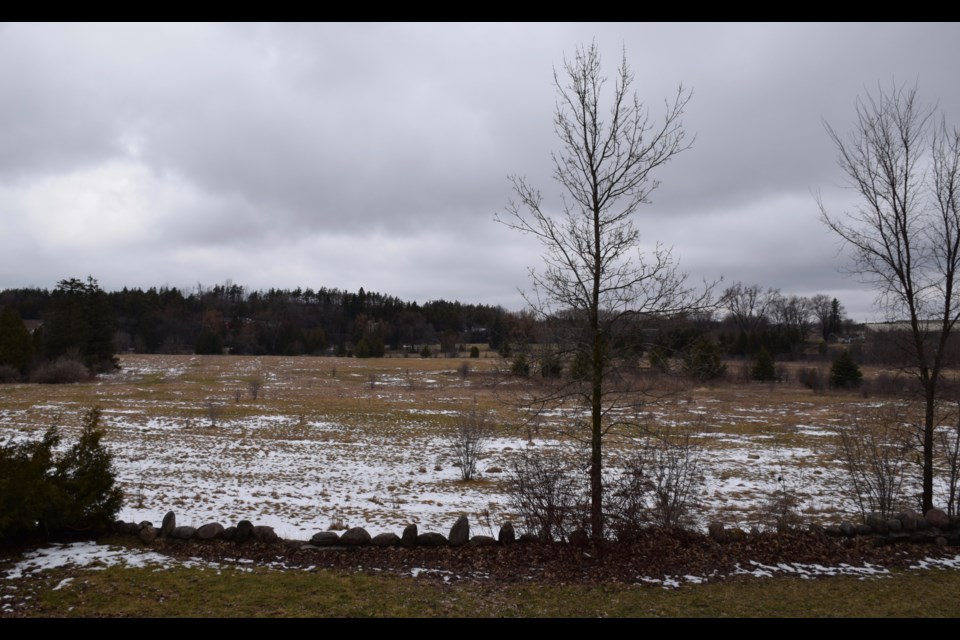Not much is happening on the sprawling, decommissioned reformatory lands in east side Guelph. But a local group appears determined to purchase a small plot of the 436 hectare (1,000-acre) Guelph Innovation District (Yorklands) property, with a plan to turn it into an ecological learning centre.
For a number of years, Yorklands Green Hub has been promoting the concept of revitalizing the small, 47-acre northeast corner of the former Guelph Correctional Centre property, using it to showcase approaches to environmental and agricultural resilience and sustainability. Historically the land was used for agriculture, and the idea of an eco-centre has been floating around for about a decade.
Now, the group is planning to launch a fundraising campaign to collect up to $3 million to purchase that sector, which includes about 60 acres of land and the historic superintendent’s house overlooking it.
One million of those dollars would be used to renovate the house and turn it into an educational centre, said Yorklands Green Hub chair and coordinator Norah Chaloner.
The land, owned by the Province of Ontario, has sat idle and virtually unused for 15 years. Yorklands Green Hub was originally going to lease land on the site, but the province has now decided to sell the land in parcels, Chaloner said.
She added that the 47-acre plot does not appear to be suitable for major residential or commercial development, given that it is “criss-crossed with water,” and has brownfield remediation challenges.
“Now that the Ministry of Infrastructure Ontario says that it is going to be sold off in parts, we are looking at a capital campaign this year, raising the money to buy the property,” Chaloner said. “We don’t know how much it’s worth. We see that a community shared space under a possible public trust might be the best way to go.”
The campaign is expected to start in the fall. For now, Yorklands Green Hub has partnered with the Guelph Community Foundation on issuing tax receipts, and is applying to become a registered charity.
Chaloner said the group has been making progress on other fronts. She said the University of Guelph ICON (Ideas Congress) program is designing a mobile learning lab as a pilot project for Yorklands Green Hub.
ICON is a program that encompasses a number of disciplines at the university, bringing senior undergraduates from across campus to work together on real-world challenges. This academic year it revolved around the idea of feeding a world population of nine billion people.
“April 11 is when the ICON students are going to present their ideas for the mobile learning lab,” she said. “We hope to be able to take that to schools and park it for a few days. We would be able to demonstrate within the mobile lab things related to the carbon cycle, the water cycle, urban agriculture, and solar energy.”
The city has ambitious plans for what has come to be called in officialdom the Guelph Innovation District, plans that include a model urban village with 7,000 residents, a research park with 9,000 jobs, a mixed-use main street, and the rejuvenation and repurposing of the historic prison building.
The project is considered integral to Guelph’s growth plans, and the vision is to focus the development on green-energy and innovation sector jobs.
It was approved in the 2014 secondary plan, but is currently stalled by an Ontario Municipal Board challenge in which residential developers have opposed the plan, arguing that the city is trying to jump the planning queue ahead of further development in south end Guelph.
Funds have not yet been allocated for the development of the district in city budgets.
Chaloner said there is contamination on the northeast plot, believed to be predominantly cadmium. It is not known precisely how bad it is, but there is a possibility that it could prevent any form of disturbance to the soil.
“That was a surprise to us,” Chaloner said. “We had thought we would have gardens in there. We will still have community gardens, but they will be above ground in raised beds and greenhouse production. We can still teach, but we may not be going into the soil.”
She does not believe the contamination is serious, but even in badly contaminated soil there is the potential to grow certain fruit and nut trees, she said, adding there is also potential for building affordable housing in the form of “tiny homes” on the property.
“We believe the province will sell us this land, if there is enough local support for the idea,” she added.
